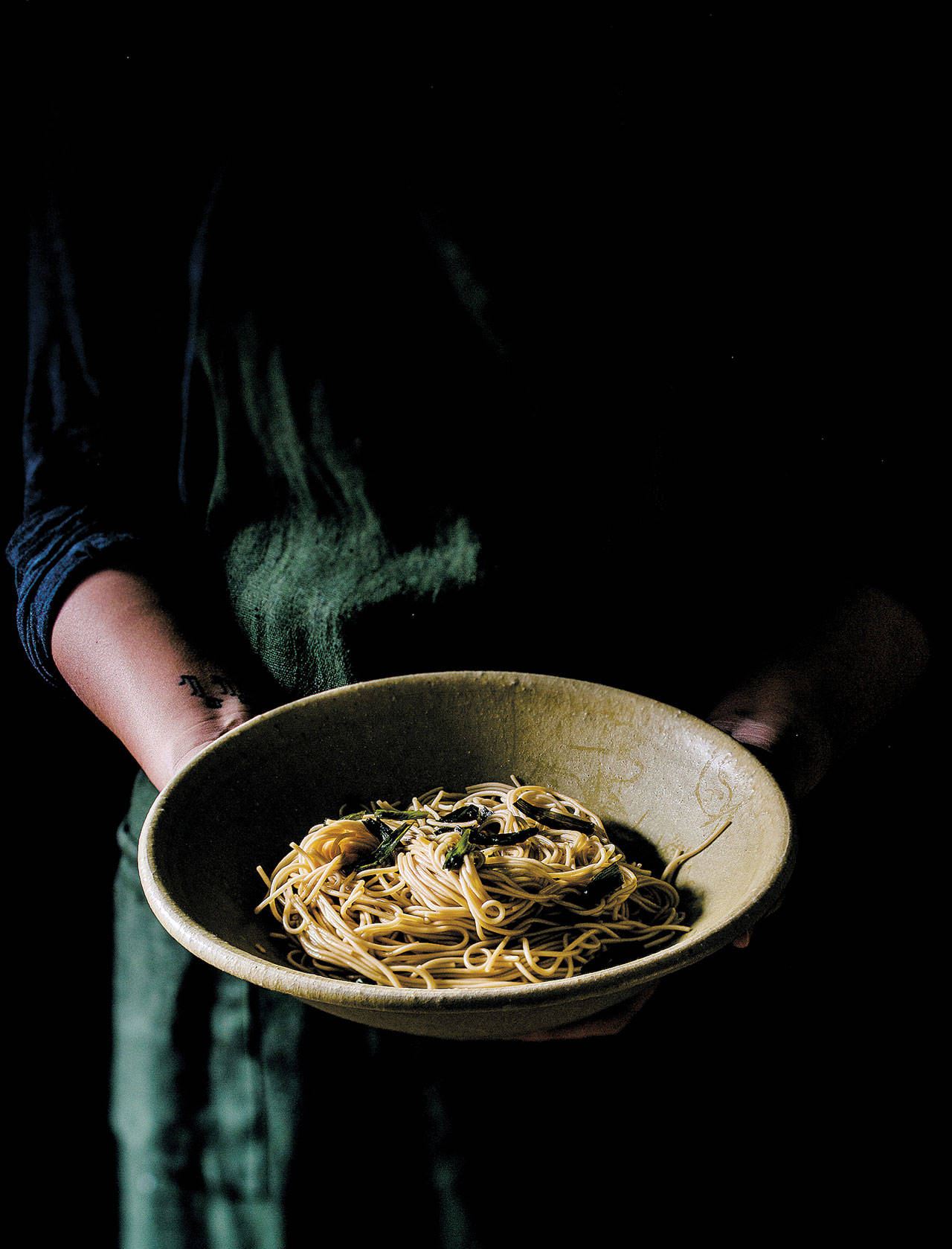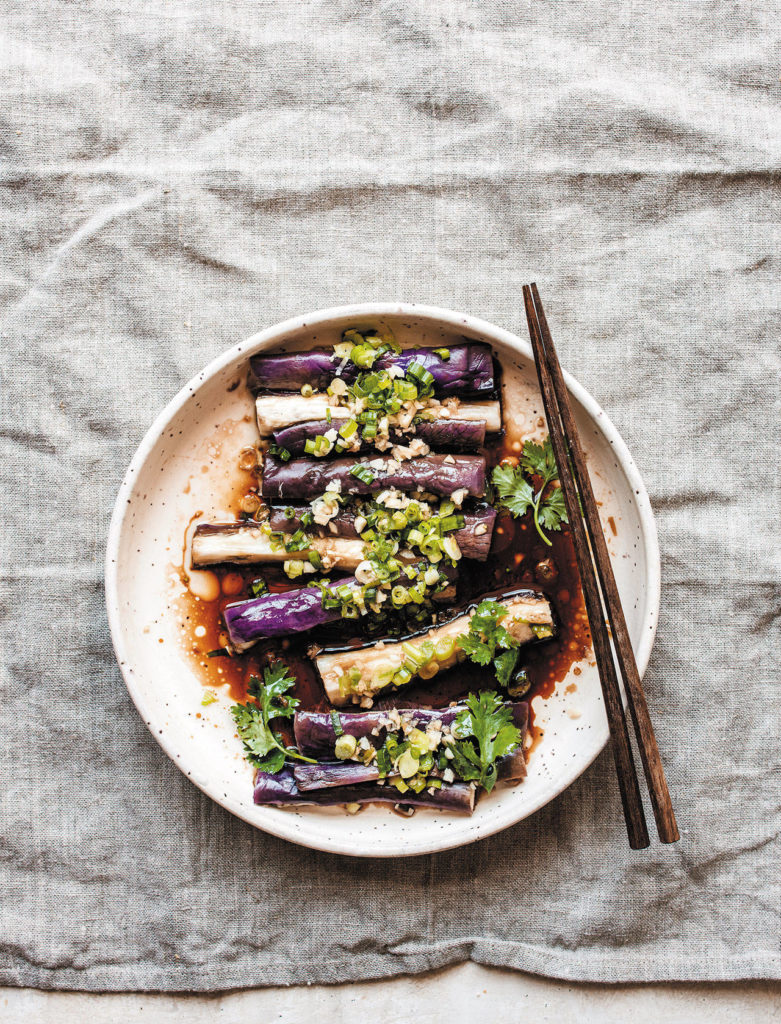I have an affinity for fictional gourmand detectives. The newest to find a place on my nightstand is Qui Xiaolong’s Inspector Chen.
Trouble is, I can only read so much of Chen’s enjoyment of fried mini-buns with minced pork stuffing, shrimp dumplings, fermented tofu skewered on bamboo sticks, rice porridge and salted duck before wanting to set aside the mystery and dig in to a meal of Shanghainese street food myself.
“My Shanghai: Recipes and Stories from a City on the Water” from cookbook author Betty Liu refers to “Old Shanghai” dishes as “ben bang cai,” or “local cuisine.” The recipes transport me to Chen’s dining table and introduce me to Liu’s Shanghai roots.
Liu conceived of “My Shanghai” watching her mother’s careful preparation of “zongzi” — glutinous rice dumplings in bamboo leaves. While her mother learned recipes through careful replication of her family’s culinary techniques, Liu felt she was missing the opportunity to continue the traditions of her family’s home cooking.
Liu explains that the layering of flavors in Shanghai cuisine is formed through fresh aromatics, like scallions and ginger, dried spices like white pepper and star anise, and three core seasonings: soy sauce, cooking wine and vinegar. Nothing exemplifies the power of these simply combined ingredients like the traditional dish of Old Shanghai — scallion oil noodles.
Scallions are slowly fried in hot oil for the better part of an hour. Then dried shrimp, a sweetened sauce of black vinegar, soy sauce and white pepper are married with fresh-cooked noodles. Drenched in the aromatic scallion sauce, this dish is delicately sweet and full of umami.
A “City on the Water,” Shanghai is situated on the East China Sea and fed by the Yangtze River. This fertile region offers a diversity of foods throughout the seasons. Shanghai dishes are a celebration of the season and the ingredient — thankfully at my supermarket, eggplant season is year-round.
At our family table, only my mother likes eggplant. Eggplant’s texture, bitterness and even the sponginess of cutting into a raw eggplant can be a little off putting. Liu describes eggplant as a polarizing vegetable, and I would agree. Because of this, I did what I always do when I don’t care for something: assume I’ve just not encountered the right preparation.
The key, of course, is quality ingredients. Using slender Chinese eggplants also helped. I had cautioned my apprehensive eggplant haters that everyone must try the dish — give it a chance to woo them. It won all of us over — no contest. My father, a vehement eggplant loather, even took seconds!
While Inspector Chen and his creator Qui Xiaolong may have pointed me to the back street food stalls of Shanghai — I’m currently reading “A Loyal Character Dancer,” book two in the Inspector Chen series — it is Liu who took me there. Her home cooking will weave its way into our seasonal plates, and I’m excited to see what flavors await.
Erin Pride-Swaney is a home cook who loves cookbooks and writes about them on her blog, Edible Shelf. For more on the specific recipes Erin tested, visit her Instagram @edibleshelf.
Scallion oil noodles
If these ingredients are a bit foreign to your pantry, there’s nothing to fear here. A single trip to H-Mart or your local Asian grocery will supply you with all you need. And, after the success of this recipe, your courage to make more of Liu’s delicious recipes will follow. It’s easy to dig out that seldom-used spice from the back of the cupboard, but because delicate white pepper is key to the heat of this dish — unless you also add chili oil — make sure your pepper is fresh and still fragrant.
1½ teaspoons dried shrimp
6 to 8 scallions, cut into 1-inch segments
3 tablespoons neutral cooking oil, such as canola or grape seed oil
1 tablespoon dark soy sauce
2 tablespoons light soy sauce
½ teaspoon black vinegar
1 tablespoon crushed rock sugar or granulated sugar
Pinch ground white pepper
½ pound fresh Shanghai-style thin noodles, cooked to al dente (or 2 servings of any dried noodles like soba or ramen)
Place the dried shrimp in a small bowl with hot water to cover and soak for 30 minutes. Drain and pat dry with a paper towel.
Smash the scallions with the side of a meat cleaver. Pat dry with a paper towel to avoid any water droplets from causing the oil to splatter during stir-frying.
Heat the oil in a well-seasoned wok over medium-low. Add the scallion segments and let them fry slowly, so they turn yellow without burning. Stir occasionally so the segments brown evenly. This slowly rendered-out flavor is essential to this recipe — be patient and let the toasty flavor infuse the oil. I usually let the scallions cook for 20 to 30 minutes, but for a deeper flavor cook them at a lower heat for longer, even up to 1 hour. I’ll often make big batches of this oil that I store in the refrigerator; for this recipe I use 3 tablespoons. Reduce the heat to low, add the shrimp, and cook for another 5 minutes.
Meanwhile, mix together the dark and light soy sauces, vinegar and sugar.
Increase the heat to medium and immediately pour the soy sauce mixture into the wok. The sauce will bubble finely and foam (if it bubbles too much, your heat is too high) and begin to caramelize. Stir to dissolve the sugar and let simmer for 2 to 3 minutes to thicken. Turn off the heat. Add a pinch of white pepper. Add the cooked noodles to the wok and toss to combine. Divide the noodles between two bowls, making sure to scoop up the scallion segments.
Seasoned steamed eggplant
I found that cutting my eggplants in thirds was sufficient and that tearing the pieces after steaming was unneeded. The trick to keeping your eggplant’s lovely purple color is in how you layer it in the steamer. “Place the bottom layer skin down to prevent oversteaming,” Liu instructs, “then pile the other eggplant segments on, crisscrossing them to create air pockets so steam can reach every piece.” You needn’t use a wok in steaming these, a large skillet will suffice, but a bamboo steamer is almost required. Don’t worry, they’re not pricey and you can pick one up at your local Asian market. Line yours with a layer of parchment. Cut holes in it for steam.
2 eggplants (about 12 ounces total), such as Japanese or Chinese varieties
2 teaspoons white vinegar
2 tablespoons light soy sauce
1½ teaspoons dark soy sauce
1 teaspoon black vinegar
1 tablespoon granulated sugar
1 teaspoon sesame oil
½ teaspoon ground white pepper
1 teaspoon minced fresh ginger
2 scallions, thinly sliced crosswise
3 cloves garlic, minced
1 tablespoons neutral cooking oil, such as canola or grape seed oil
2 teaspoons red chili oil (optional)
1½ teaspoons toasted white sesame seeds
Cilantro leaves
Cut off the base of each eggplant, then cut each eggplant into 3 segments. Halve each segment lengthwise so that you have 6 pieces total per eggplant.
Add the white vinegar to a large bowl of water. Add the eggplant pieces and let them sit in the vinegar water for 10 to 15 minutes.
Set a bamboo steamer over 2 inches of water in a wok, and bring the water to a boil over high. Place a layer of eggplant skin side down in the steamer, then pile the remaining pieces on top, working in batches if necessary.
Cover and steam the eggplant over high for 5 to 7 minutes, until soft and easily pierced with a chopstick. The texture should be silky soft and creamy but still firm enough to hold its shape. Set the steamed eggplant aside in a colander to cool slightly.
Meanwhile, mix together the light and dark soy sauces, black vinegar, sugar, sesame oil and white pepper. Set the sauce aside.
When the eggplant is cool enough to handle, tear each piece lengthwise into strips about ⅜ inch wide. Arrange the eggplant strips on a plate. Pile the ginger, half of the scallions, and the garlic in the center of the eggplant.
In a small saucepan, heat the oil until it bubbles when a chopstick is inserted, 2 to 3 minutes. Pour the hot oil over the aromatics. They should sizzle and release a gorgeous fragrance.
Drizzle the soy sauce mixture and chili oil, if using, over the eggplant. Top with the remaining scallions, the toasted sesame seeds, and cilantro leaves. Serve immediately at room temperature.
— Recipes reprinted by permission from the book “My Shanghai” by Betty Liu. published by Harper Design, an imprint of HarperCollins Publishers.
“My Shanghai”
By Betty Liu
Harper Design. 288 pages. $28.
Who should buy this? Cookbook lovers who enjoy a personal journey paired with personal food. Any untraveled, COVID-restriction-fatigued home cook looking for an adventure.
Talk to us
> Give us your news tips.
> Send us a letter to the editor.
> More Herald contact information.


























